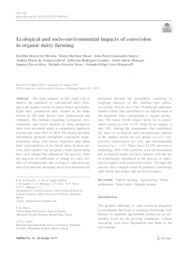Ecological and socio-environmental impacts of conversion to organic dairy farming.
Ecological and socio-environmental impacts of conversion to organic dairy farming.
Author(s): OLIVEIRA, E. R. de; MUNIZ, E. B.; SOARES, J. P. G.; GABRIEL, A. M. de A.; GANDRA, J. R.; MENEGAT, A. S.; SILVA, J. T.; NEVES, N. F.; MARQUES, O. F. C.
Summary: Abstract The main purpose of this study was to analyze the transition of conventional dairy farming to an organic system in family-based agriculture. Eight dairy production units located in the Mato Grosso do Sul state, Brazil, were implemented and evaluated. The fndings regarding ecological, environmental, and social impacts of these productive units were presented under a comparative approach, between the years 2012 to 2014. The dataset included information gathered throughout experiment implementation, along with survey responses later taken from representatives of the family units. In these surveys, each variable was assigned a value representing how such change has infuenced the activity. After the insertion of coefcients of change for each variable of environmental and ecological indicators per unit of production, an impact factor was automatically calculated through the spreadsheet consisting of weighing matrices of the Ambitec-Agro indicator system. Fifteen out of the 25 analyzed indicators reached values that contributed to an improvement in the migration from conventional to organic production. The mean overall impact factor for a conventional system (µ) was−0.55, while for an organic, it was 3.82. Among the components that contributed the most to ecological and environmental indexes in the organic system are soil quality (µ=4.7), biodiversity conservation (µ=2.0), and environmental recovery (µ= −1.5). There was a 14.55% increase in technology (PIT) with a positive socio-environmental and ecological impact for dairy farmers with the use of technologies introduced in the process of transition to organic milk production system. Through this process, new concepts could be produced considering each family unit project and the local scenario.
Publication year: 2022
Types of publication: Journal article
Unit: Embrapa Cerrados
Keywords: Agricultura Familiar, Agroecologia, Produção Orgânica
Observation
Some of Embrapa's publications are published as ePub files. To read them, use or download one of the following free software options to your computer or mobile device. Android: Google Play Books; IOS: iBooks; Windows and Linux: Calibre.
Access other publications
Access the Agricultural Research Database (BDPA) to consult Embrapa's full library collection and records.
Visit Embrapa Bookstore to purchase books and other publications sold by Embrapa.

